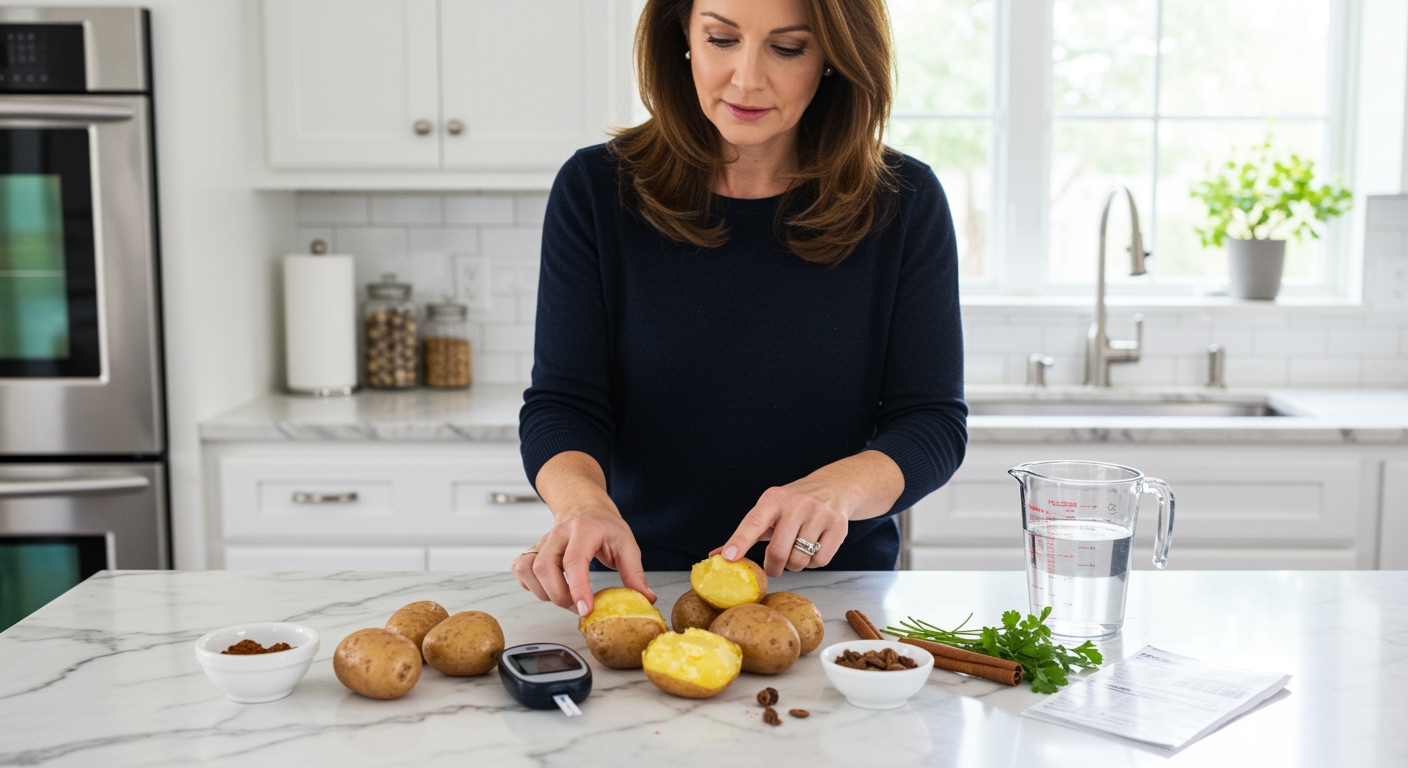✪ Key Takeaway: Boiled potatoes can be part of a diabetes-friendly diet when eaten in proper portions with the skin on and cooled before eating.
Introduction
You stare at that boiled potato on your plate and wonder if it will send your blood sugar through the roof.
This confusion happens because you have heard conflicting advice about potatoes and diabetes from different sources.
Hi, I am Abdur, your nutrition coach and today I am going to explain exactly how boiled potatoes affect your blood sugar and when they can fit into your diabetes management plan.
How Does Boiling Change Potato Nutrition?
Boiling transforms potatoes in ways that can actually benefit people with diabetes compared to other cooking methods.
The boiling process breaks down some of the starch structure, which can make the potato easier to digest and potentially cause a more gradual blood sugar rise.
When you boil potatoes with their skin on, you preserve most of the fiber, potassium, and vitamin C that naturally occur in the vegetable.
The water-based cooking method does not add any extra fats or oils that could complicate blood sugar management.
Research shows that boiled potatoes have a lower glycemic index than baked or fried potatoes, meaning they cause a slower and more controlled blood sugar response.
✪ Pro Tip: Always boil potatoes with the skin on to maximize fiber content and slow down sugar absorption.
What Happens To Blood Sugar After Eating Boiled Potatoes?
Your blood sugar response to boiled potatoes depends on several key factors that you can control.
A medium boiled potato contains about 30 grams of carbohydrates, which will raise blood sugar levels in most people with diabetes.
The glycemic index of boiled potatoes ranges from 56 to 89 depending on the variety, with waxy potatoes like red or new potatoes having lower values.
Your blood sugar typically peaks about 30 to 60 minutes after eating boiled potatoes, then gradually returns to baseline over 2 to 3 hours.
The fiber content in the potato skin helps slow down this blood sugar rise by creating a barrier that slows carbohydrate absorption in your small intestine.
Studies indicate that people with well-controlled diabetes can include moderate portions of boiled potatoes without causing dangerous blood sugar spikes.
✪ Fact: Cooling boiled potatoes after cooking increases resistant starch content, which further slows blood sugar absorption.
Which Type Of Boiled Potato Works Best For Diabetes?
Not all potatoes affect your blood sugar the same way, even when boiled using identical methods.
Waxy potatoes like red, new, or fingerling varieties contain more moisture and less starch than russet or Idaho potatoes.
These waxy varieties have a lower glycemic index because their cellular structure resists breaking down during cooking.
Small new potatoes are particularly good choices because you can eat them whole with the skin, maximizing your fiber intake per serving.
Purple potatoes contain anthocyanins, which are antioxidants that may help improve insulin sensitivity over time.
Sweet potatoes, while technically different vegetables, also work well when boiled because they contain more fiber and have a more gradual effect on blood sugar.
✪ Note: Choose smaller potatoes to naturally control portion sizes and reduce total carbohydrate intake per meal.
How Much Boiled Potato Can You Safely Eat?
Portion control becomes the most critical factor when including boiled potatoes in your diabetes meal plan.
A safe serving size for most people with diabetes is about half a cup or one small potato weighing around 3 ounces.
This portion contains approximately 15 grams of carbohydrates, which equals one carbohydrate exchange in diabetes meal planning.
You should always pair boiled potatoes with protein and healthy fats to slow down the absorption of carbohydrates.
Good combinations include boiled potatoes with grilled chicken, fish, or a small amount of olive oil and herbs.
Monitor your blood sugar 2 hours after eating to understand how your body responds to different portion sizes and combinations.
✪ Pro Tip: Use a kitchen scale to weigh portions until you can accurately estimate serving sizes by sight.
What Are The Best Ways To Prepare Boiled Potatoes For Diabetes?
The way you prepare and serve boiled potatoes can significantly impact their effect on your blood sugar levels.
Always wash potatoes thoroughly but leave the skin on during boiling to maximize fiber content and nutritional value.
Boil potatoes until they are just tender, not mushy, because overcooking breaks down more starch and increases the glycemic response.
After boiling, let the potatoes cool completely before eating to increase the resistant starch content.
Season with herbs, spices, or a small amount of healthy fats like olive oil instead of butter or high-fat sauces.
Consider making potato salad with vinegar-based dressing, as the acetic acid in vinegar can help slow carbohydrate absorption.
Avoid adding high-carbohydrate toppings like sour cream, cheese, or bacon bits that can compound blood sugar effects.
✪ Fact: Adding lemon juice or vinegar to boiled potatoes can reduce their glycemic impact by up to 30 percent.
The Bottom Line
Boiled potatoes can absolutely be part of a healthy diabetes management plan when you choose the right varieties, control portions, and prepare them properly.
The key to managing diabetes is not avoiding foods completely but learning how to include them safely and enjoyably in your daily routine.
I would love to hear about your experiences with potatoes and blood sugar management, so please share your questions or feedback in the comments section below.
References
At NutritionCrown, we use quality and credible sources to ensure our content is accurate and trustworthy. Below are the sources referenced in creating this article:
- PMC: Potato Consumption and Risk of Type 2 Diabetes
- Diabetes Care Community: Diabetes and Potatoes: What Are the Best Types
- WebMD: Carbs, Potatoes, and Blood Sugar
- News Medical: How Potatoes Can Improve Cardiometabolic Health





